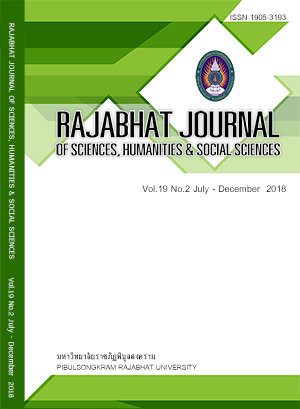THE CONTRIBUTION OF ORGANIC COMTAMINANTS IN CASE LEACHATE LEAKED TO ENVIRONMENT
Keywords:
leachate, organic hydrocarbon substance, landfill siteAbstract
The purpose of this study was to assess the distribution of organic hydrocarbon substances in case of leachate and effluent from Nakorn Lampang municipality landfill site leak to environment. Leachate and effluent were collected and analyzed their characterizations, compositions and contaminants. Gas chromatography and mass spectrometry technique were used to identify organic hydrocarbon contaminants in leachate and effluent. Then the mathematical model Fugacity-Base Environmental Equilibrium Partitioning Model Level I was applied to the impact of leachate percolation to environment. The results found 36 organic hydrocarbon compounds existed in landfill leachate and effluent. Both of them consisted of 2-hydroxy-1-(hydroxymethyl) ethyl ester, 9-Octadecenoic acid, Cyclopropaneoctanal, 9,17-Octadecadienal, Phenol, Benzene, Oxime, and Phenanthrene as majority substances. Almost these substances were less toxicant and harmfulness. However, high compositions of volatile organic compounds such as benzene and phenol were also detected, indicating hazardous substances contamination in environment can be occur. In case leachate percolation at landfill site, phenol and benzene can be distributed to 8 villages within 5 kilometers around Nakorn Lampang municipality landfill site. The 94% of phenol may distribute to aquatic phase. The concentration of it in aquatic phase may be 5.714 mg/m3 whereas other phases found very rare. Benzene also found in this case and almost of it may be contaminated in atmosphere around 99% by weight with the concentration of 53.5 ng/m3.The leftover may distribute in aquatic phase. The results indicated that the leaking leachate and effluent from the landfill site have a minimal impact on the groundwater resource and others phase of environment.
References
American Public Health Association. Standard methods for the examination of water and wastewater, American Public Health Association. Washington DC: American Water Works Association, Water Environment Federation, 1995.
Aziz HA, Adlan MN, Amilin K. et al. Quatification of leachate generation rate from a semi-aerobic landfill in Malaysia. Environmental Engineering & Management Journal (EEMJ). 2012; 11(9): 1581-1585.
Aziz QS, Mojiri A. Composition of Leachate, Control and Treatment of Landfill Leachate for Sanitary Waste Disposal. USA: IGI Global, 2015.
Babich H, Davis LD. Phenol: A review of environmental and health risk, Regulatory Toxicology and Pharmacology. 1981; 1(1): 90-109.
Bakraouy H, Souabi S, Digua K. et al. Removal of phenol and surfactant from landfill leachate by coagulation flocculation process. Scientific Study & Research. 2015; 16(4): 329-341.
Balaji K, Kilimozhi D. GC-MS Analytical of various extracts of Clerodendrum Phlomidis leaf. International Journal of Pharmacy and Pharmaceutical Science. 2014; 6(1): 226-232.
Bates LM, Bigot M, Cropp R. et al. On the formulation of environmental fugacity models and their numerical solutions. Environmental Toxicology and Chemistry. 2016; 35(9): 2182-2191.
Booty GW, Wong WSI. Application of a fugacity model for assessing chemical fate in ecodistricts of southern Ontario, Ecological Modelling. 1996; 84(1-3): 245-263.
Gupta A, Paulraj R. Leachate composition and toxicity assessment: an integrated approach correlating physicochemical parameters and toxicity of leachates from MSW landfill in Delhi, Environmental Technology. 2017; 38(13-14): 1599-1605.
Jayawardhana Y, Kumarathilaka P, Weerasundara L. et al. Detection of benzene in landfill leachate from Gohagoda dumpsite and its removal using municipal solid waste derived biochar. Proceeding on 6th International Conference on Structural Engineering and Construction Management 2015, Kandy, Sri Lanka, 11-13th December 2015, 50-55.
Kulikowska D. Nitrogen removal from landfill leachate via the nitrite route, Brazilian Journal of Chemical Engineering. 2012; 29(2): 7307-7318.
Kylefors K, Evaluation of leachate composition by multivariate data analysis (MVDA), Journal of Environmental Management. 2003; 68(4): 367-376.
Mackay D. Multimedia Environmental Models: The Fugacity Approach. Chelsea, USA: Lewis Publishers Inc., 2000.
Mackay D, Guardo DA, Paterson S. et al. Assessing the fate of new and existing chemicals: A five stage process, Environmental. Toxicology Chemistry. 1996; 15(9): 1618-1626.
Mackay D, Paterson S. Evaluating the multimedia fate of organic chemicals: a level III fugacity model, Environmental Science and Technology. 1991; 25(1): 427-436.
Mojiri A, Ziyang L. Phenols and manganese removal from landfill leachate and municipal wastewater using the constructed wetland, International Journal of Environmental Chemical Ecological Geological and Geophysical Engineering. 2015; 9(8): 974-977.
Naveen PB, Mahapatra MD, Sitharam GT. et al. Physico-chemical and biological characterization of urban municipal landfill leachate. Environmental Pollution. 2017; 220: 1-12.
Romeh AA. Phytochemicals from Ficussycomorus L. Leaves act as insecticides and acaricides, African journal of agricultural research. 2013; 8(27): 3571-3579.
Tchobanoglous G, Theisen H, Vigil S. Integrated Solid Waste Management: Engineering Principles and Management Issues. USA: McGraw-Hill, 1993.
Wiszniowski J, Surmacz-Górska J, Robert D. et al. The effect of landfill leachate composition on organics and nitrogen removal in an activated sludge system with bentonite additive. Journal of Environmental Management. 2007; 85(1): 59-68.
Downloads
Published
How to Cite
Issue
Section
License
Each article is copyrighted © by its author(s) and is published under license from the author(s).










